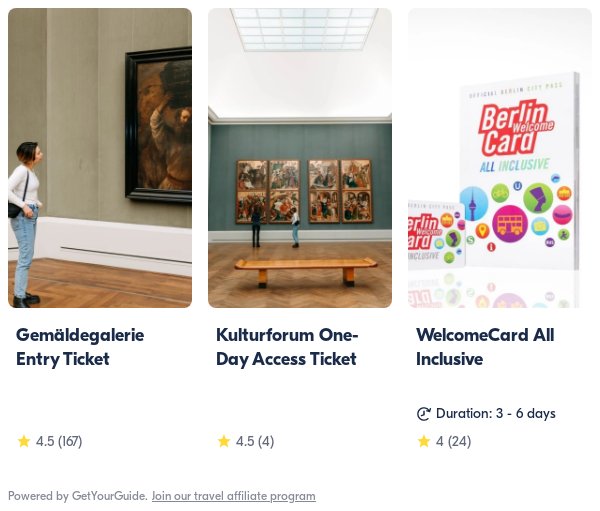Italian highlights in the Gemäldegalerie Paintings Gallery in Berlin include a fantastic Renaissance art collection and the ever-popular Caravaggio’s Amor Victorious.
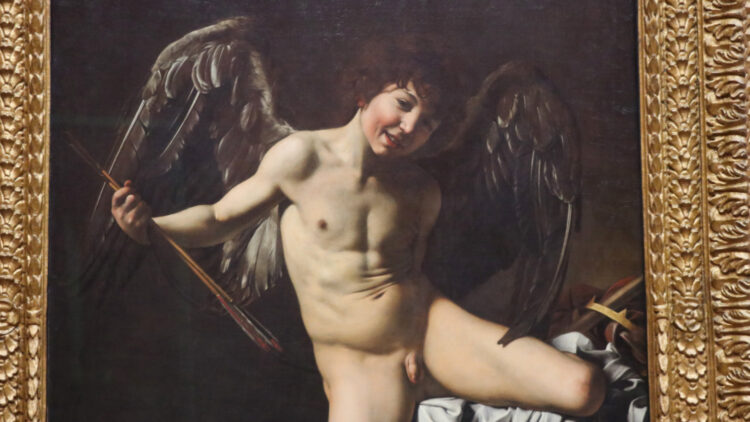
The Italian art collection in the Gemäldegalerie (Paintings Gallery) in Berlin is of astonishing quality. The art museum covers Italian paintings from the early Renaissance to the Baroque period with excellent works by all notable masters from all significant periods. The collection of Renaissance paintings is particularly praised. Quality works by amongst others Fra Angelico, Botticelli, Titian, Raphael, Canaletto, and Tiepolo are on display. Arguably the most popular painting in the museum is Caravaggio’s scandalously erotic Amor Victorious. Buy Gemäldegalerie tickets online for skip-the-line admission to this fantastic art museum.
Italian Paintings in the Gemäldegalerie in Berlin
The Gemäldegalerie’s collection of Italian paintings is of the same high standard as the German and Dutch art. The early Italian paintings from the 13th to 16th centuries form the largest section of the collection and the works exhibited give an excellent overview of the development of Italian painting from the early Renaissance. The collection of Italian paintings from the 17th and 18th centuries is smaller but of an equally high standard.
Unfortunately, visitors to the Gemäldegalerie following the normal route from the early German paintings to the Dutch Golden Age and then down via 17th and 18th-century European art, arrive at the Italian Renaissance paintings not only exhausted (mea culpa) but also see them in reverse chronological order. This is a pity, as the museum’s collection is vast, of top quality, and able to give visitors a thorough overview of the development of Italian painting from the early Renaissance to the Baroque.
Starting a museum visit with the Italian section as described here is usually possible too but will result in the same exhaustion when reaching the early German paintings.
Gemäldegalerie: 200 Masterpieces of European Painting is a beautiful book (but heavy and pricy) — much of the information in the book is available for free when searching the online catalog of the Gemäldegalerie.
Italian Renaissance Highlights in the Gemäldegalerie Berlin
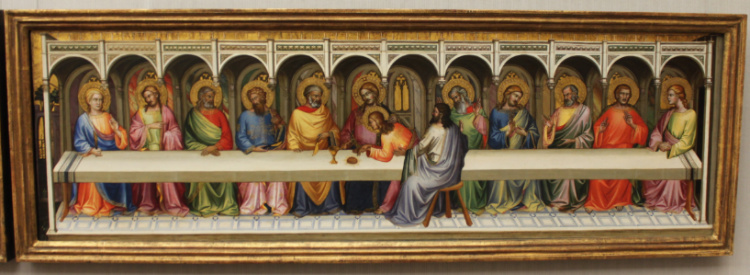
All major Italian painters of the Renaissance is represented amongst others Taddeo Gaddi, Masaccio, Fra Filippo Lippi, Filippo Lippi, Giovanni Bellini, Domenico Ghirlandaio, Andrea Mantegna, Antonello da Messina, and Andrea del Verrocchio.
A few standout artists and works in this section include:
Fra Angelico
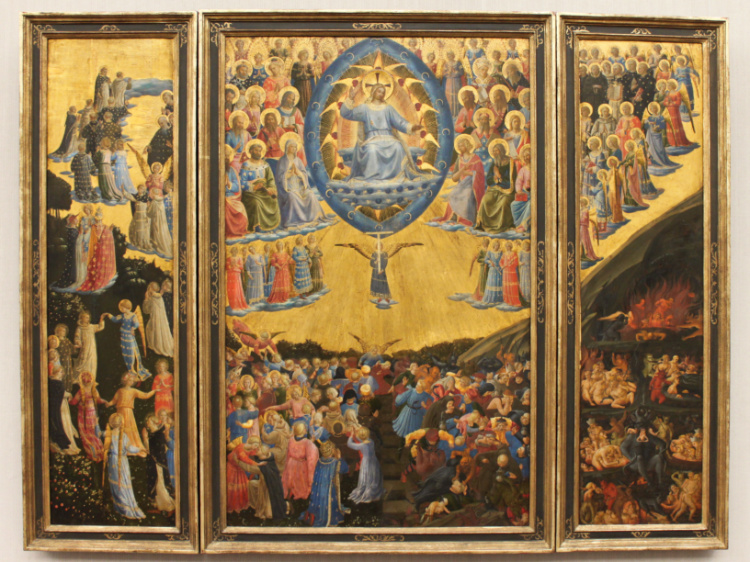
Fra Angelico’s, Das jüngste Gericht / The Last Judgment (1435) is a typical last judgment painting with the separation of the saved and the damned. Note how the woman in red trying to sneak in with the saved is pushed by an angel towards hell.
Fra Angelico’s hell is typical Dante, quite different from that of Hieronymus Bosch and early German painters.
(The largest collection of Fra Angelico paintings is in the marvelous Museum of San Marco in Florence.)
Carlo Crivelli
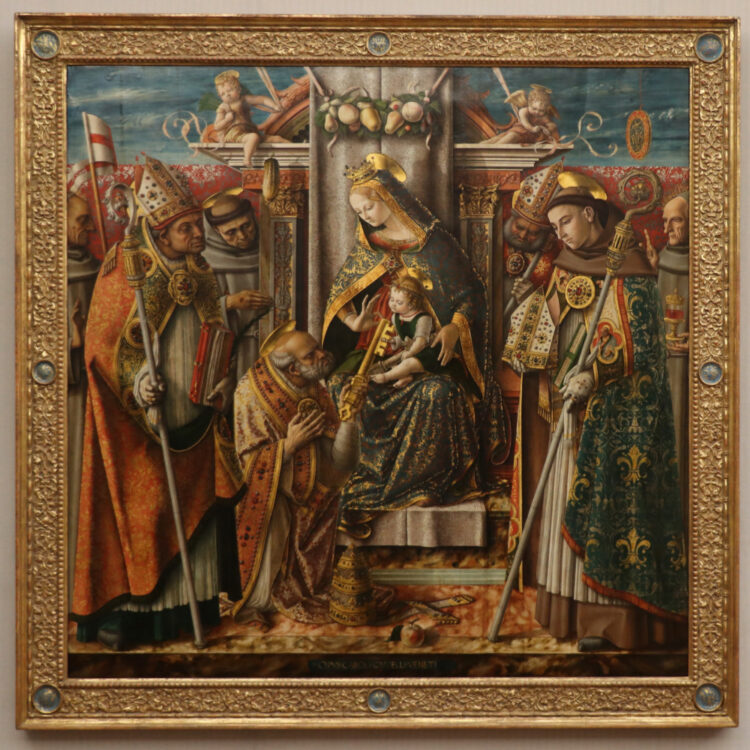
Thronende Maria mit dem Kind, die Schlüsselübergabe an den Apostel Petrus und mit den Heiligen Johannes Capistranus, Emidius, Franziskus, Ludwig von Toulouse, dem seligen Giacomo della Marca und einem Bischof / Enthroned Mary with Child and Handing of the Keys to Peter (etc), (1488) by Carlo Crivelli has almost as much detail in the patterns of the garments as names in the title.
Sandro Botticelli
Certainly not as famous as his works in the Uffizi, the Sandro Botticelli paintings in the Gemäldegalerie are still of exquisite quality. The altar panel Madonna with the Saints (1485) has a typical Fra Angelico subject of an enthroned Madonna with two saints but the architectural elements were removed with the baldachin formed by palm trees.
It is easier to recognize the painter of Primavera in the round painting Mary with the Child and Singing Angels. The large painting of Venus (1490), has her standing naked and without props, not even Amor, as if cut from Botticelli’s famous The Birth of Venus.
Raphael
The Gemäldegalerie has five paintings of the Madonna by Raphael (Raffael in German), including the round Terranuova Madonna (1505).
Titian
The Gemäldegalerie has a notable self-portrait by Titian (Tizian in German) but more interesting is his Venus mit dem Orgelspieler / Venus with the Organ Player (1550). Venus is in the fairly standard position of lying naked (with cupid at her head) but the organist at her feet, pipe organ and all, is less common (although Titian painted various versions). Interpretations vary, but a pipe organ, even a relatively small Italian baroque one, remains a strange instrument for wooing a courtesan.
Italian Baroque Paintings in the Gemäldegalerie in Berlin

Caravaggio’s Amor Triumphant — Top Painting in the Gemäldegalerie
Possibly the most famous and most popular painting in the museum is the scandalous Caravaggio painting of Amor:
Caravaggio (Michelangelo Merisi), “Omnia vincit amor” / Amor als Sieger / Amor Triumphant (1601-2), aka as Love Conquers All, Amor Victorious, Victorious Cupid, Love Triumphant, Love Victorious, or Earthly Love)
Following Virgil — “Omnia vincit amor” (Love Conquers All) — Caravaggio painted the young god of love, Amor, as victorious over science, art, power, and fame. Volumes have been written over Caravaggio (and this painting) and although probably not seen as similarly erotic in period, it cannot be ignored that young Amor pushes his genitals forward to the center while the arrows and the left wing tip also clearly point at his crotch. Sex is the clear winner. Matters were not helped by Caravaggio using one of his students (and possibly lover) as the model for a less than convincing cupid face (and painting the same face for biblical figures in other paintings).
The painting originally belonged to Marchese Vincenzo Giustiniani (1564-1637) who built up one of the finest art collections in Italy. Omnia vincit amor was the final painting in his gallery — often covered by a curtain, not out of embarrassment but rather to make the big unveil at the end of the tour the more dramatic.
Still, the painting caused a bit of a scandal so Vincenzo’s bother, Cardinal Benedetto Giustiniani (1544-1637) commissioned Der himmlische Amor besiegt den irdischen Amor / Sacred Love and Profane Love (or The Divine Eros Defeats the Earthly Eros and various other variants) (1602-03) from Giovanni Baglione. Here a divine Eros clad in armor triumphs over an earthly Amor — still naked but no genitals on view. This was more in line with official Catholic norms that earthly love should be tempered and restricted to marriage. (Forget for a moment that amor / eros / cupid are not actually biblical figures.) (In a second version painted by Baglione, the satyr was changed to a devil with facial features resembling Caravaggio — now in the Palazzo Barberini in Rome.)
Caravaggio and Baglione remained rivals, threatened and sued for libel, and competed for clients. Caravaggio had the misfortune of dying first and that Baglione wrote the first Caravaggio biography. He couldn’t really criticize the art, as the quality was plain for all to see, but slandered Caravaggio’s character and questionable morals. Four centuries later, Caravaggio has the last laugh — these two paintings hang in the Gemäldegalerie separated by only a doorway and many visitors would miss the Baglione completely if it was not for the clear reference to it in the audio guide description of Amor Victorious.
Cecco del Caravaggio
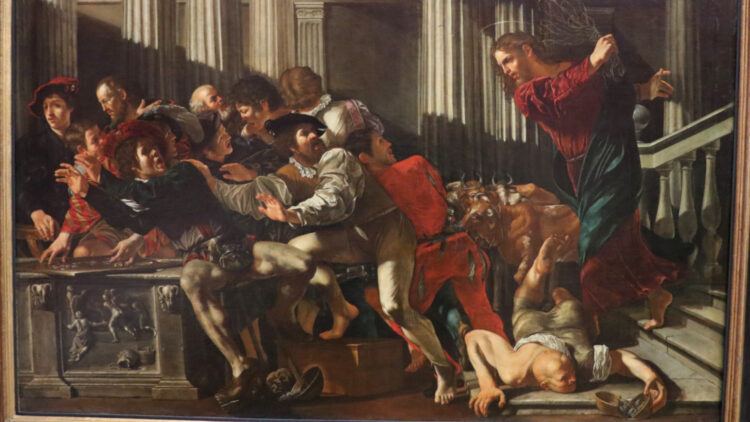
Cecco del Caravaggio (possibly Francesco Boneri), who many assumed was the model for Caravaggio’s Amor, painted Christus vertreibt die Wechsler aus dem Tempel / Christ Driving the Money Changers from the Temple (1610-15).
Canaletto Giovanni Antonio Canal

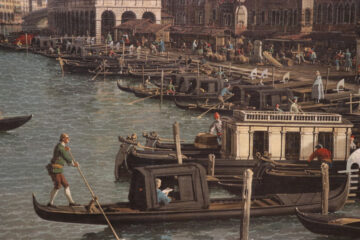
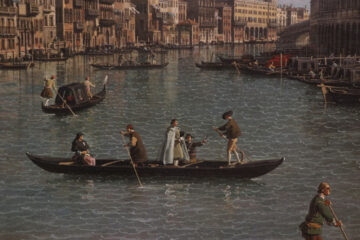
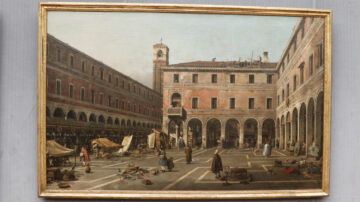
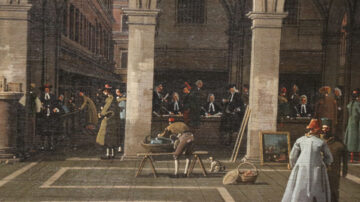
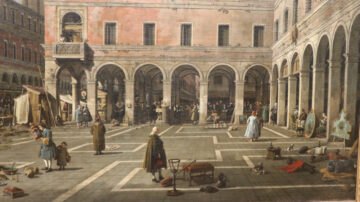
The Gemäldegalerie exhibits several large paintings of Venice by Giovanni Antonio Canal, aka Canaletto. These paintings are worth a close-up look as there is almost photographic detail in some minor scenes such as gondolas in Canal Grande (1758/63) and market traders in Campo di Rialto (1758/63).
Giovanni Battista Tiepolo
Nearby, in stark contrast is the rather grim Das Martyrium der Heiligen Agathe / The Martyrdom of St Agatha (1755) by Giovanni Battista Tiepolo. Where many artists portrayed the saving of St Agathe from prison, Tiepolo preferred to depict her martyrdom where both her breasts were sliced off.
Further European art from the 17th and 18th centuries follows but the collection of paintings from England, France, Spain, and Germany is far smaller and of less quality than the Italian exhibition. Far more impressive are world-famous collections of Dutch, Flemish, and German paintings from the 13th to 17th centuries.
→→ See Highlights of German and Dutch paintings in the Gemäldegalerie for more details on the rest of the Paintings Gallery’s best works.
See Visiting the Gemäldegalerie in Berlin for opening hours, tickets, and more visitor’s information.
Gemäldegalerie: 200 Masterpieces of European Painting is a beautiful book (but heavy and pricy) — much of the information in the book is available for free when searching the online catalog of the Gemäldegalerie.
More on the Berlin State Museums (Staatliche Museen zu Berlin):
Note new opening times for many Berlin museums from mid-April 2024. Timeslot reservations are essential only for the Caspar David Friedrich exhibition (until 4 August 2024) but sensible (and sometimes needed in busy periods!) for the Alte Nationalgalerie, Gemäldegalerie, Neue Nationalgalerie, Neues Museum, and Pergamon – Das Panorama. (The Pergamon Museum itself is closed until 2027!). Timeslots are released only a few weeks in advance. Online tickets are available from GetYourGuide, which seems to have timeslots available when SMB has already sold out. Many passes and multi-museum tickets are again sold (Kulturforum / Museums Island). Individual museum ticket prices range from €8 to €14 (€20 for special exhibitions). Online tickets are skip-the-line — go directly to the gallery entrance to scan the code but pick up free audioguides first.
For more general information on the Berlin State Museums:
- Top National Museums and Galleries in Berlin (brief overview)
- Berlin State Museums: What Is Seen Where? (a short description of the collections in the different museums)
- Opening Hours of Berlin State Museums (2024) — major changes from mid-April 2024!
- Ticket Prices for Berlin State Museums (prices for museums, temporary exhibitions, combination tickets, online time-slot reservations). Buying online from GetYourGuide is easy. A ticket with a QR or bar code is scanned directly at the entrance — no need to pass by the ticket desk (but pick up the free audio guide before entering).
- Save with the Berlin Museum Pass – 30 museums (including all the SMB museums) in three days for €32 – a fantastic savings deal.
- Staatliche Museen zu Berlin (official website in German & English).
News & Temporary Exhibitions:
- 2024: Overview of Top Berlin Exhibitions in 2024, Caspar David Friedrich in the Alte Nationalgalerie (tickets are selling out fast!), Frans Hals in the Gemäldegalerie, Neue Nationalgalerie (20th-century art) Hamburger Bahnhof Contemporary Art, Kupferstichkabinett (Prints and Drawings), and Photography Museum.
- Museums closed in 2024: The Pergamon Museum is closed until 2027 (some sculptures are on display in Das Panorama), the Museum Berggruen is closed until 2025 (much of its collection is traveling the world), the permanent collection of the German History Museum (Zeughaus) is closed but temporary exhibitions continue in the Pei Building.
More Museum Reviews and Museum-Specific Information:
- Alte Nationalgalerie with Caspar David Friedrich paintings (2024 special exhibition).
- Altes Museum with Greek, Etruscan, and Roman art.
- Ethnological and Asian Art Museums in the Humboldtforum.
- Friedrichswerdersche Kirche (free admission) with a collection of 19th-century German sculptures.
- Gemäldegalerie with its collection of German and Dutch Old Masters and Italian paintings.
- Kunstgewerbemuseum (Decorative Arts).
- Musical Instruments Museum near the Berliner Philharmonie.
- Neue Nationalgalerie — 20th-century art.
- Neues Museum with bust of Nefertiti.
- Pergamon Museum with Ishtar Gate — the whole Pergamonmuseum is closed from October 2023 until 2027. Some Greek sculptures are shown in the
- Pergamon Museum Panorama Exhibition with Asisi panoramic painting and Greek statues.
- Photography — Helmut Newton collection and historic photos.
Previous Temporary Exhibitions:
- 2023: Top Special Temporary Exhibitions in 2023 — overview, in the Kulturforum, in the Neue Nationalgalerie, on Museum Island, and the Museum of Photography.
- 2022: Top Special Temporary Exhibitions in 2022 — overview, in the Kulturforum (David Hockney), in the Neue Nationalgalerie, on Museumsinsel, Hamburger Bahnhof contemporary art, and the Museum of Photography.
- 2021: Top Special Temporary Exhibitions in 2021 — including the reopening of the Neue Nationalgalerie, as well as the Ethnological and Asian Art Museums in the Humboldt Forum.
- 2020: Highlights, in Kulturforum, on Museum Island, in the Hamburger Bahnhof, smaller museums, and the opening of the Humboldt Forum.

